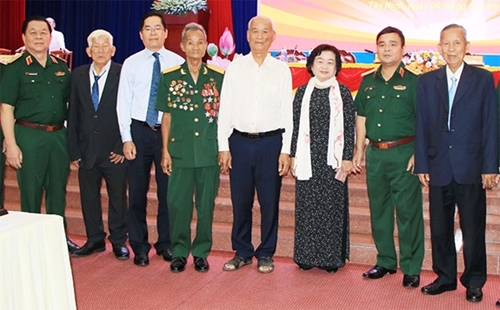At the conference, Senior Lieutenant General Nguyen Trong Nghia, Deputy Director of the General Department of Politics of the Vietnam People’s Army, stressed in his introductory presentation that the victory of Tua Hai confirmed the sound leadership of the Party via Resolution No.15.
Despite the signing of the Geneva Accords in July 1954, the U.S. imperialists, with their plot of replacing France in Vietnam and dividing the two countries for good, increased aid for the Saigon Government. With the U.S. support, the Saigon Government carried out numerous raids, causing great losses and pains to the people in the South, posing new challenges to the revolution of Vietnam. Resolution No.15 was born in that context.
    |
 |
|
Delegates participate in the event. |
Under the guidance of Resolution No.5, the Party Committee of South Vietnam led the revolutionary armed forces of Southeastern Vietnam and troops and people of Tay Ninh province to make the resounding victory of Tua Hai. The victory was the U-turn for the revolutionary movement, starting the “Dong Khoi” (concerted uprising) movement in the South, lifting the revolutionary movement from a passive posture to a period of active offensives with various other victories. Resolution No.15 has, thus, gone down in history as an important milestone, serving as a decisive factor for shaping the situation of Vietnam’s revolution, and having a strong affect on the whole Southern theater at the time.
Tua Hai base was located in Dong Khoi commune, Chau Thanh district of Tay Ninh province and was a stronghold of Saigon Regiment 32 (Division 21). This was also the operational-level storage depot of the enemy troops. Neutralizing the base would deal a great blow to the whole defensive system of the enemy and also get the revolutionary forces more weapons and ammunition. The Party Committee of South Vietnam, therefore, decided to attack the base on the early morning of January 26, 1960 with the main forces comprising the Military Command of the Southeastern region and the troops and locals of Tay Ninh province. In a close-up and surprising battle, the revolutionary forces quickly gained control and earned the final victory, killing 76 enemy troops and dissolving 400 others, capturing 1,500 guns, and more.
The victory of Tua Hai tested the combat capacities of the Southeastern armed forces. It has gone far beyond being a normal battle, as it marked a new development in the organization and capabilities to conduct combat operations and coordination among the armed forces of the region. In fact, it is the manifestation of the Vietnamese military art, the art of choosing and striking the right targets, the art of creating and seizing opportunities, the art of keeping secret and conducting unexpected offensives. It is also the art of combining military operations with political affairs, closely coordinating the power of the commando force and the combined armed teams in offensive operations and the uprising of the masses.
Among the 70 presentations sent to the conference, many provide in-depth analysis, highlighting the significance of the victory, as it strengthened the confidence of the locals in the victory of the whole military and people. The victory was ensured by the combination of military operations and the uprising of the masses, in which military operations mostly supported the masses in their struggles, making the enemy unable to suppress the masses. The support of the armed forces for the masses to rise up brought the synergy for the general uprising later. This explained why the victory served as the opener for the “Dong Khoi” movement in Southern Vietnam.
Participants at the conference then drew a good number of lessons learned. They are lessons of independence, autonomy and creativity in shaping the revolutionary guideline of the Party and a lesson on pro-activeness and creativity in thoroughly applying the Party’s resolutions to reality. They also include lessons on strengthening the Party’s leadership over the development of the armed forces, the building of a revolutionary, regular and elite military - a powerful three-force military, and the maintenance of the whole people’s defense posture in combination with the people’s security disposition, and more.
Concluding the event, Deputy Defense Minister Senior Lieutenant General Le Chiem highlighted that the conference reached their set targets and each presentation served as a separate scientific study, providing evidence and opinions explaining the significance of the victory. He stressed that the conference was an activity in tribute to those who sacrificed their lives for national independence and freedom.
|
The same day, the Party Committee, People’s Council, People’s Committee, and Vietnam Fatherland Front Committee of Tay Ninh province solemnly held the 60th anniversary of the Victory of Tua Hai (January 26, 1960 – 2020). On this occasion, the conference’s organizing committee visited and presented lunar New Year gifts to national contributors in the area of Tua Hai Victory. |
Translated by Huu Duong